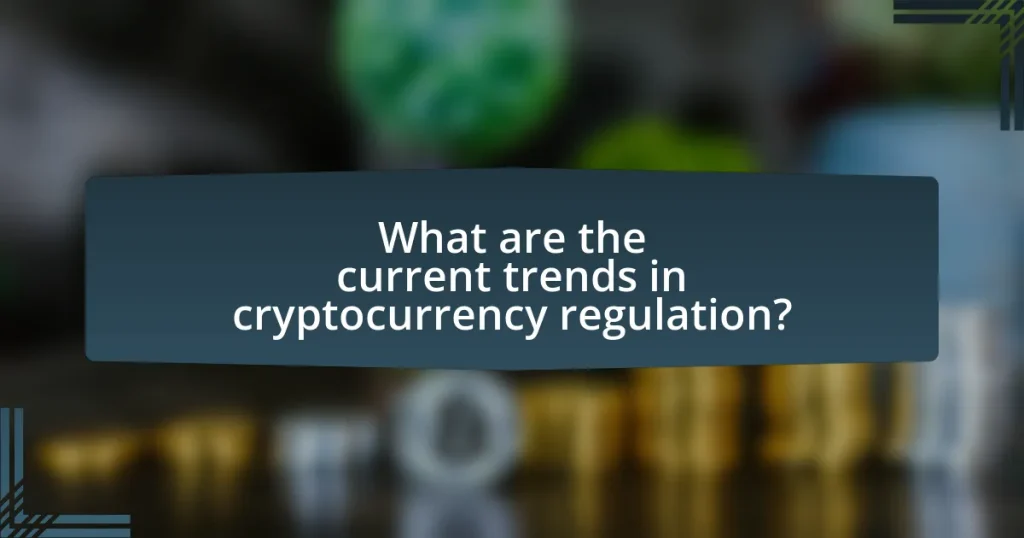The article focuses on the future trends in cryptocurrency regulation over the next five years, highlighting the increasing scrutiny from governments and the establishment of clearer regulatory frameworks aimed at consumer protection and market integrity. It discusses how various countries are approaching regulation differently, with examples from the European Union’s Markets in Crypto-Assets (MiCA) framework and the U.S. Securities and Exchange Commission’s (SEC) actions. The article also examines the role of international organizations like the Financial Action Task Force (FATF) in shaping regulations, the challenges of creating a unified global framework, and the anticipated impacts of regulatory changes on cryptocurrency markets and businesses. Key areas of focus include compliance measures, consumer protection laws, and strategies for businesses and investors to navigate the evolving regulatory landscape.

What are the current trends in cryptocurrency regulation?
Current trends in cryptocurrency regulation include increased scrutiny from governments worldwide, the establishment of clearer regulatory frameworks, and a focus on consumer protection. Regulatory bodies, such as the U.S. Securities and Exchange Commission (SEC) and the European Union, are actively working to define the legal status of cryptocurrencies and initial coin offerings (ICOs). For instance, the SEC has classified certain cryptocurrencies as securities, which subjects them to existing securities laws. Additionally, the Financial Action Task Force (FATF) has introduced guidelines for anti-money laundering (AML) and combating the financing of terrorism (CFT) that many countries are adopting. These trends indicate a shift towards more comprehensive and standardized regulations aimed at fostering innovation while ensuring market integrity and consumer safety.
How are governments around the world approaching cryptocurrency regulation?
Governments around the world are approaching cryptocurrency regulation with a mix of caution and innovation, aiming to balance consumer protection, financial stability, and technological advancement. For instance, the European Union is working on the Markets in Crypto-Assets (MiCA) regulation, which seeks to create a comprehensive framework for digital assets, ensuring transparency and accountability. In contrast, countries like China have implemented strict bans on cryptocurrency trading and Initial Coin Offerings (ICOs) to mitigate financial risks. Meanwhile, the United States is adopting a more fragmented approach, with different states enacting varying regulations, while federal agencies like the SEC and CFTC are increasingly focusing on enforcement actions against fraudulent activities in the crypto space. This diverse regulatory landscape reflects the ongoing global debate on how best to integrate cryptocurrencies into existing financial systems while addressing concerns related to security, taxation, and illicit activities.
What specific regulations have been implemented in major economies?
Major economies have implemented specific regulations such as the European Union’s Markets in Crypto-Assets (MiCA) framework, which aims to provide a comprehensive regulatory framework for cryptocurrencies and stablecoins. In the United States, the Securities and Exchange Commission (SEC) has increased scrutiny on cryptocurrency exchanges and Initial Coin Offerings (ICOs), classifying many tokens as securities. Additionally, the Financial Action Task Force (FATF) has established guidelines for anti-money laundering (AML) and combating the financing of terrorism (CFT) that member countries, including major economies, are adopting to regulate cryptocurrency transactions. These regulations reflect a global trend towards increased oversight and standardization in the cryptocurrency sector.
How do these regulations impact cryptocurrency businesses and users?
Regulations significantly impact cryptocurrency businesses and users by establishing legal frameworks that govern operations and transactions. These regulations can enhance consumer protection, ensuring that users are safeguarded against fraud and market manipulation, which is crucial given the volatility and risks associated with cryptocurrencies. For instance, the implementation of Know Your Customer (KYC) and Anti-Money Laundering (AML) regulations requires businesses to verify user identities, thereby increasing compliance costs but also fostering trust among users. Furthermore, regulatory clarity can attract institutional investment, as firms are more likely to engage in markets that are well-regulated. According to a report by the Financial Action Task Force (FATF), countries that have adopted comprehensive regulatory measures have seen increased participation from both businesses and users, indicating that regulations can lead to a more stable and secure cryptocurrency ecosystem.
What role do international organizations play in cryptocurrency regulation?
International organizations play a crucial role in cryptocurrency regulation by establishing frameworks and guidelines that promote cooperation among countries. These organizations, such as the Financial Action Task Force (FATF) and the International Monetary Fund (IMF), provide recommendations for anti-money laundering (AML) and combating the financing of terrorism (CFT) that member states are encouraged to adopt. For instance, the FATF’s guidelines on virtual assets aim to ensure that countries implement effective regulatory measures to mitigate risks associated with cryptocurrencies. This collaborative approach helps harmonize regulations across jurisdictions, facilitating a more stable and secure global cryptocurrency market.
How do organizations like the Financial Action Task Force influence regulations?
Organizations like the Financial Action Task Force (FATF) influence regulations by establishing international standards for combating money laundering and terrorist financing, which member countries are encouraged to adopt. The FATF conducts mutual evaluations of its members, assessing their compliance with these standards, and publishes reports that highlight best practices and areas for improvement. This process creates pressure on countries to align their national regulations with FATF recommendations, thereby shaping the regulatory landscape globally. For instance, the FATF’s 2019 guidance on virtual assets prompted many jurisdictions to develop specific regulations for cryptocurrency, illustrating its significant impact on regulatory frameworks.
What are the challenges of creating a unified regulatory framework globally?
Creating a unified regulatory framework globally faces significant challenges due to differing national interests, legal systems, and economic conditions. Countries prioritize their own regulatory goals, which can lead to conflicting regulations and hinder international cooperation. For instance, the European Union’s MiCA regulation aims to create a comprehensive framework for cryptocurrencies, but its implementation may clash with the regulatory approaches of countries like the United States, which has a more fragmented regulatory landscape. Additionally, varying levels of technological advancement and financial literacy among nations complicate the establishment of a one-size-fits-all framework. These factors contribute to the difficulty in achieving consensus on regulatory standards that can be uniformly applied across borders.

What are the anticipated changes in cryptocurrency regulation over the next five years?
Anticipated changes in cryptocurrency regulation over the next five years include increased regulatory clarity, the establishment of comprehensive frameworks, and enhanced consumer protection measures. Governments and regulatory bodies worldwide are expected to implement clearer guidelines to address issues such as taxation, anti-money laundering (AML), and know-your-customer (KYC) requirements. For instance, the European Union’s Markets in Crypto-Assets (MiCA) regulation aims to create a unified regulatory framework across member states, which is expected to be finalized by 2024. Additionally, the U.S. Securities and Exchange Commission (SEC) is likely to continue its efforts to classify cryptocurrencies and tokens, leading to more defined regulations. These developments are driven by the growing adoption of cryptocurrencies and the need to mitigate risks associated with fraud and market volatility.
How might technological advancements affect cryptocurrency regulation?
Technological advancements will likely lead to more sophisticated and adaptive cryptocurrency regulation. As blockchain technology evolves, regulators may implement real-time monitoring systems to track transactions and ensure compliance with anti-money laundering (AML) and know your customer (KYC) regulations. For instance, advancements in artificial intelligence can enhance the ability to detect fraudulent activities and suspicious patterns, prompting regulators to adapt their frameworks accordingly. Additionally, the rise of decentralized finance (DeFi) platforms may push regulators to create new guidelines that address the unique challenges posed by these systems, ensuring consumer protection while fostering innovation.
What emerging technologies are likely to influence regulatory practices?
Emerging technologies likely to influence regulatory practices include blockchain, artificial intelligence, and machine learning. Blockchain technology enhances transparency and traceability in transactions, which can streamline compliance and auditing processes. Artificial intelligence and machine learning can analyze vast amounts of data to detect fraudulent activities and assess risks in real-time, thereby improving regulatory oversight. These technologies are increasingly being integrated into regulatory frameworks to adapt to the evolving landscape of cryptocurrency and financial markets.
How can regulators keep pace with rapid innovation in the cryptocurrency space?
Regulators can keep pace with rapid innovation in the cryptocurrency space by adopting a flexible regulatory framework that encourages collaboration with industry stakeholders. This approach allows regulators to stay informed about emerging technologies and trends, enabling them to create regulations that are both effective and adaptable. For instance, the Financial Action Task Force (FATF) has established guidelines that promote international cooperation and information sharing among countries, which helps regulators respond swiftly to changes in the cryptocurrency landscape. Additionally, engaging in continuous dialogue with cryptocurrency firms and technology experts can provide regulators with insights into the latest developments, ensuring that regulations remain relevant and effective.
What are the potential impacts of regulatory changes on cryptocurrency markets?
Regulatory changes can significantly impact cryptocurrency markets by influencing investor confidence, market liquidity, and the overall adoption of digital assets. For instance, stricter regulations may lead to reduced participation from retail investors due to increased compliance costs and perceived risks, which can decrease market liquidity. Conversely, clear and supportive regulations can enhance investor confidence, potentially leading to greater institutional investment and broader market acceptance. Historical examples include the 2017 ICO boom, where regulatory scrutiny led to a sharp decline in new projects and investments, demonstrating how regulatory actions can directly affect market dynamics.
How might stricter regulations affect market volatility and investor confidence?
Stricter regulations are likely to reduce market volatility and enhance investor confidence. By establishing clearer rules and standards, regulations can mitigate risks associated with fraud and market manipulation, which often contribute to price swings. Historical examples, such as the implementation of the Dodd-Frank Act in 2010, show that increased regulatory oversight can stabilize financial markets by fostering transparency and accountability. Consequently, as investors perceive a safer environment, their willingness to participate in the market may increase, leading to greater overall confidence.
What opportunities could arise from a more regulated cryptocurrency environment?
A more regulated cryptocurrency environment could lead to increased institutional investment. This is evidenced by the fact that regulatory clarity often encourages large financial institutions to enter markets, as seen in traditional finance sectors. For instance, after the implementation of clearer regulations in the stock market, institutional investment surged, demonstrating a similar potential for cryptocurrencies. Additionally, enhanced consumer protection measures could foster greater public trust, resulting in wider adoption and usage of cryptocurrencies. This trust is crucial, as surveys indicate that a significant percentage of potential investors cite regulatory uncertainty as a barrier to entry. Therefore, a regulated environment could not only attract institutional players but also expand the overall market by reassuring individual investors.

What specific regulatory trends should stakeholders monitor closely?
Stakeholders should closely monitor the trend of increased regulatory scrutiny on cryptocurrency exchanges and DeFi platforms. Regulatory bodies worldwide are implementing stricter compliance measures, such as Know Your Customer (KYC) and Anti-Money Laundering (AML) requirements, to mitigate risks associated with fraud and illicit activities. For instance, the Financial Action Task Force (FATF) has issued guidelines that many countries are adopting, which emphasize the need for transparency and accountability in cryptocurrency transactions. This trend is expected to intensify as governments seek to protect consumers and stabilize financial markets, making it crucial for stakeholders to stay informed about evolving regulations and compliance obligations.
What are the key areas of focus for regulators in the coming years?
Regulators will focus on consumer protection, anti-money laundering (AML) compliance, and the establishment of clear frameworks for digital asset classification in the coming years. Consumer protection will address risks associated with cryptocurrency investments, ensuring that investors are informed and safeguarded against fraud. Anti-money laundering compliance will involve stricter regulations to prevent illicit activities, as evidenced by the Financial Action Task Force’s (FATF) guidelines urging countries to implement robust AML measures for virtual assets. Additionally, regulators will work on defining digital assets to create a consistent regulatory environment, which is crucial for fostering innovation while ensuring market integrity.
How will consumer protection laws evolve in relation to cryptocurrencies?
Consumer protection laws will evolve to provide clearer regulations and safeguards for cryptocurrency users. As the cryptocurrency market matures and incidents of fraud and market manipulation increase, regulatory bodies are likely to implement stricter guidelines to protect consumers from risks associated with digital assets. For instance, jurisdictions like the European Union are already working on comprehensive frameworks, such as the Markets in Crypto-Assets Regulation (MiCA), which aims to enhance transparency and accountability in the crypto space. This evolution will likely include requirements for exchanges to register, adhere to anti-money laundering protocols, and ensure the security of consumer funds, thereby fostering a safer environment for cryptocurrency transactions.
What measures are being considered to combat fraud and money laundering in the crypto space?
Regulatory authorities are considering several measures to combat fraud and money laundering in the crypto space, including implementing stricter Know Your Customer (KYC) requirements, enhancing transaction monitoring, and enforcing anti-money laundering (AML) regulations. KYC measures require cryptocurrency exchanges and service providers to verify the identities of their users, which helps prevent anonymous transactions that can facilitate illicit activities. Enhanced transaction monitoring involves using advanced analytics and machine learning to detect suspicious patterns in crypto transactions, allowing for timely intervention. Additionally, many jurisdictions are looking to align their regulations with the Financial Action Task Force (FATF) guidelines, which advocate for comprehensive AML frameworks that include virtual assets. These measures aim to create a safer and more transparent environment in the cryptocurrency market, thereby reducing the risks associated with fraud and money laundering.
How can cryptocurrency businesses prepare for future regulatory changes?
Cryptocurrency businesses can prepare for future regulatory changes by implementing robust compliance frameworks and staying informed about evolving regulations. Establishing a dedicated compliance team ensures that businesses can adapt to new laws and guidelines as they emerge. Regular training for employees on compliance issues and legal obligations is essential to maintain awareness of regulatory developments. Additionally, engaging with industry associations and participating in advocacy efforts can provide insights into potential regulatory shifts. Monitoring global regulatory trends, such as the European Union’s Markets in Crypto-Assets Regulation, can also help businesses anticipate changes and adjust their strategies accordingly.
What best practices should companies adopt to ensure compliance?
Companies should adopt a comprehensive compliance framework that includes regular risk assessments, employee training, and adherence to regulatory guidelines. Implementing a robust compliance program helps identify potential risks and ensures that employees are aware of their responsibilities regarding regulations. For instance, the Financial Action Task Force (FATF) recommends that businesses in the cryptocurrency sector conduct thorough due diligence and maintain transparent records to comply with anti-money laundering (AML) and counter-terrorism financing (CTF) regulations. Additionally, staying updated with evolving regulations and engaging with legal experts can further enhance compliance efforts.
How can businesses engage with regulators to shape future policies?
Businesses can engage with regulators to shape future policies by actively participating in public consultations and providing feedback on proposed regulations. This engagement allows businesses to voice their concerns and suggest improvements based on industry insights. For instance, the Financial Industry Regulatory Authority (FINRA) often seeks input from financial firms during rule-making processes, demonstrating how stakeholder feedback can influence regulatory outcomes. Additionally, forming coalitions or industry groups can amplify a business’s voice, as seen in the cryptocurrency sector where organizations like the Blockchain Association advocate for favorable regulations. Such collaborative efforts can lead to more informed and balanced policy decisions that consider both regulatory objectives and business realities.
What practical steps can investors take to navigate the evolving regulatory landscape?
Investors can navigate the evolving regulatory landscape by staying informed about regulatory changes and engaging with legal experts. Regularly reviewing updates from regulatory bodies, such as the SEC and CFTC, helps investors understand new compliance requirements. Additionally, participating in industry forums and discussions can provide insights into best practices and emerging trends. Engaging with legal professionals ensures that investors receive tailored advice on compliance and risk management, which is crucial as regulations continue to evolve.
How can investors stay informed about regulatory developments?
Investors can stay informed about regulatory developments by regularly monitoring official government websites, subscribing to industry newsletters, and following reputable financial news outlets. Government websites, such as the U.S. Securities and Exchange Commission, provide updates on new regulations and policy changes. Industry newsletters often summarize key developments and provide analysis, while financial news outlets report on significant regulatory changes and their implications for the market. Additionally, participating in webinars and industry conferences can offer insights from experts on upcoming regulatory trends.
What strategies can help mitigate risks associated with regulatory changes?
To mitigate risks associated with regulatory changes, organizations should implement proactive compliance strategies, including continuous monitoring of regulatory developments, engaging with legal experts, and conducting regular risk assessments. Continuous monitoring allows organizations to stay informed about potential changes in regulations, while engaging with legal experts ensures that they receive timely advice on compliance requirements. Regular risk assessments help identify vulnerabilities and prepare for potential impacts of regulatory shifts. These strategies are supported by the fact that organizations that actively engage in compliance activities are better positioned to adapt to regulatory changes, as evidenced by studies showing that proactive compliance reduces the likelihood of penalties and enhances operational resilience.










